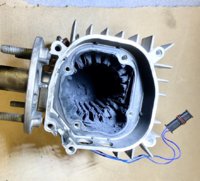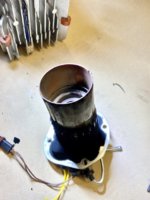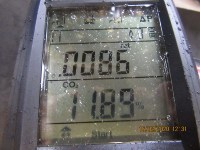For the 2nd time, since being installed as part of a conversion (November 2018), my Webasto Air Top 2000 STC B (petrol) has failed.
The symptoms are problems when starting, though it did eventually start, followed some time later by tripping and giving the F 02 error code (Flame failure - at least > 3). This could be reset, and it would run again for a while before tripping again. I even had it running at maximum temperature setting for 28 minutes (yes it was getting hot in the van by then) in an attempt to burn off any soot deposits in the exhaust (as advised by my installer after the last “issue”), but it still tripped off. After one more attempt (20 minutes this time) it tripped off for the final time showing 12 flashes for “Heater unit lock-out”.
When this started last night, I had just under ¼ tank of fuel, so still well above the red line, but I was planning on filling up anyway, and managed to put 58 litres of Shell V-Power in the 80 litre tank, which confirmed the gauge reading. So I would like to think that this hasn’t been caused by the fuel level being too low, and air getting in the heater fuel pipe.
On the last occurrence, the installers were a bit non-committal as to what the problem was, but did say that the exhaust was quite coked up, and advised me to run the heater at a higher temperature every now and again to clear it. This was at the end of summer, and while the heater had been on frequently (I sleep in my van 2 – 3 times a week), it often only switched to heat for a short time in the early hours. They said that this “light” usage could be promoting the coking up of the exhaust, which I find a bit disappointing as that is how I need to use my heater.
One other thing that was suggested, was the Prins Injector Care fuel additive that I am advised to use once every 10,000 miles to care for the LPG conversion also on my van.
So, can any of the heater gurus out there offer any advice on what may be going on? Is it the light way I use it, the fuel additive, or an air blockage? Is it something else or do I have a defective unit?
The symptoms are problems when starting, though it did eventually start, followed some time later by tripping and giving the F 02 error code (Flame failure - at least > 3). This could be reset, and it would run again for a while before tripping again. I even had it running at maximum temperature setting for 28 minutes (yes it was getting hot in the van by then) in an attempt to burn off any soot deposits in the exhaust (as advised by my installer after the last “issue”), but it still tripped off. After one more attempt (20 minutes this time) it tripped off for the final time showing 12 flashes for “Heater unit lock-out”.
When this started last night, I had just under ¼ tank of fuel, so still well above the red line, but I was planning on filling up anyway, and managed to put 58 litres of Shell V-Power in the 80 litre tank, which confirmed the gauge reading. So I would like to think that this hasn’t been caused by the fuel level being too low, and air getting in the heater fuel pipe.
On the last occurrence, the installers were a bit non-committal as to what the problem was, but did say that the exhaust was quite coked up, and advised me to run the heater at a higher temperature every now and again to clear it. This was at the end of summer, and while the heater had been on frequently (I sleep in my van 2 – 3 times a week), it often only switched to heat for a short time in the early hours. They said that this “light” usage could be promoting the coking up of the exhaust, which I find a bit disappointing as that is how I need to use my heater.
One other thing that was suggested, was the Prins Injector Care fuel additive that I am advised to use once every 10,000 miles to care for the LPG conversion also on my van.
So, can any of the heater gurus out there offer any advice on what may be going on? Is it the light way I use it, the fuel additive, or an air blockage? Is it something else or do I have a defective unit?



